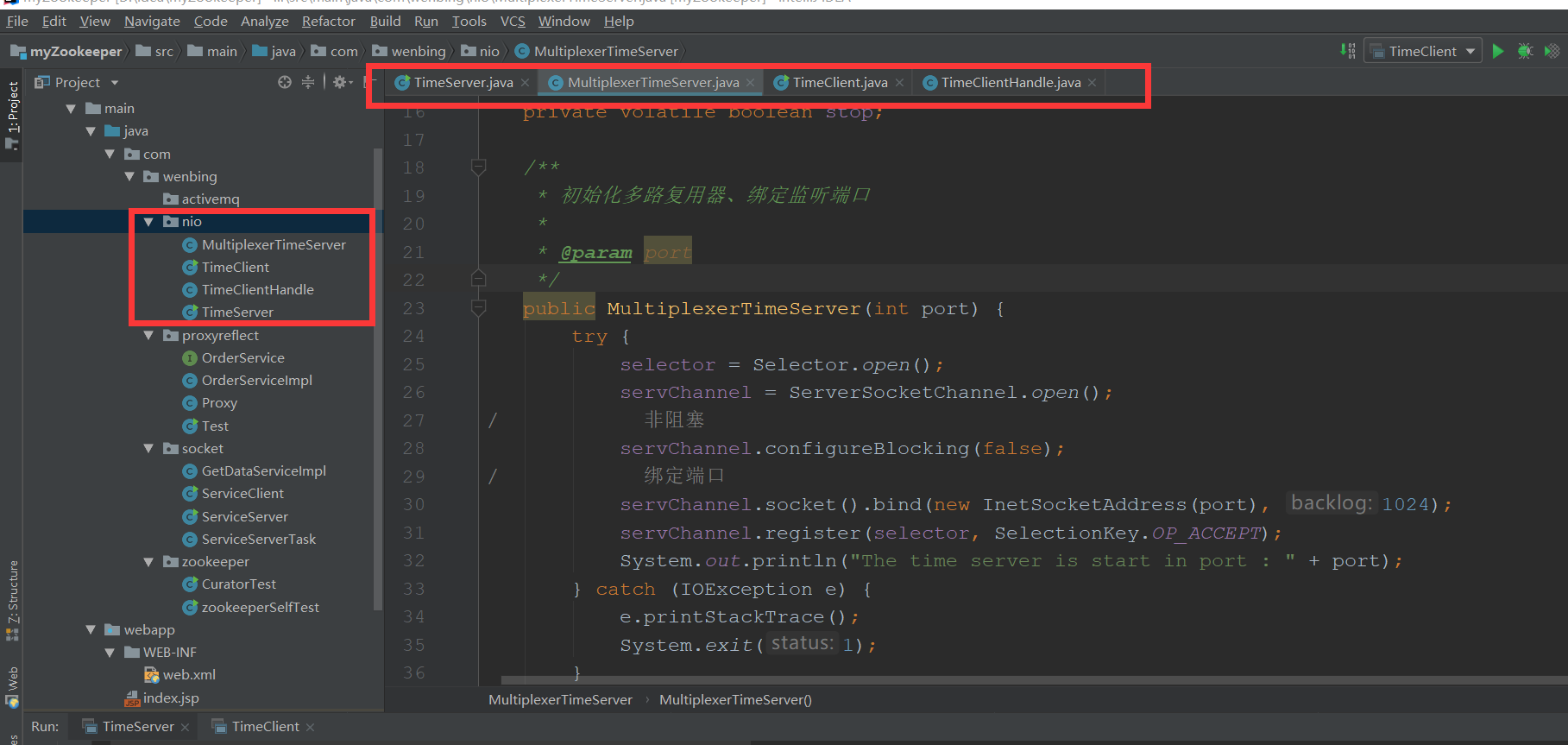nio原理和示例代码
我正在为学习大数据打基础中,为了手撸rpc框架,需要懂得nio的原理,在搞懂nio框架前,我会带着大家手撸一些比较底层的代码,当然今后当我们学会了框架,这些繁琐的代码也就不用写了,但是学一学底层的代码也是有好处的嘛。
java.nio全称java non-blocking IO(实际上是 new io),是指jdk1.4 及以上版本里提供的新api(New IO) ,为所有的原始类型(boolean类型除外)提供缓存支持的数据容器,使用它可以提供非阻塞式的高伸缩性网络。
前面我写的socket的服务端与客户端的通信是线程阻塞的,这在实际应用场景中并不竟如人意,我们更多需要的是异步操作,用户无感知,当我们在操作主线程的时候,一些通信相关的线程不应该阻塞我们的主线程。我们需要传送数据,我们只要将请求发送出去,这时候具体的发送细节就应该交由底层的操作系统帮我们完成,我们应该可以操作主线程继续完成其他事情。nio就为我们解决这些事情提供了很好的办法。
学会nio之前我们需要了解这几个概念:
Channel:

先定义一个TimeServer
package com.wenbing.nio;
public class TimeServer {
public static void main(String[] args) {
int port = 8085;
if (args != null && args.length < 0) {
port = Integer.valueOf(args[0]);
}
MultiplexerTimeServer timeServer = new MultiplexerTimeServer(port);
new Thread(timeServer,"NIO-MultiplexerTimeServer-001").start();
}
}
再定义一个MultiplexerTimeServer去实现Runnable接口,每个通信的操作交由这一个线程去完成。
package com.wenbing.nio; import java.io.IOException;
import java.net.InetSocketAddress;
import java.nio.ByteBuffer;
import java.nio.channels.*;
import java.util.Iterator;
import java.util.Set; public class MultiplexerTimeServer implements Runnable { private Selector selector; private ServerSocketChannel servChannel; private volatile boolean stop; /**
* 初始化多路复用器、绑定监听端口
*
* @param port
*/
public MultiplexerTimeServer(int port) {
try {
selector = Selector.open();
servChannel = ServerSocketChannel.open();
// 非阻塞
servChannel.configureBlocking(false);
// 绑定端口
servChannel.socket().bind(new InetSocketAddress(port), 1024);
servChannel.register(selector, SelectionKey.OP_ACCEPT);
System.out.println("The time server is start in port : " + port);
} catch (IOException e) {
e.printStackTrace();
System.exit(1);
}
} public void stop() {
this.stop = true;
} @Override
public void run() {
while (!stop) {
try {
selector.select(1000);
// 查询存在的活跃的key
Set<SelectionKey> selectedKeys = selector.selectedKeys();
// 迭代所有活跃的key,进行操作
Iterator<SelectionKey> it = selectedKeys.iterator();
SelectionKey key = null;
while (it.hasNext()) {
key = it.next();
// 拿到某个key后,就将其从迭代器里除去
it.remove();
try {
handleInput(key);
} catch (Exception e) {
if (key != null) {
key.cancel();
if (key.channel() != null) {
key.channel().close();
}
}
}
}
} catch (Throwable t) {
t.printStackTrace();
}
} // 多路复用器关闭后,所有注册在上面的Channel和Pipe等资源都会被自动去注册并关闭,所以不需要单个关闭
if (selector != null) {
try {
selector.close();
} catch (IOException e) {
e.printStackTrace();
}
}
} private void handleInput(SelectionKey key) throws IOException { if (key.isValid()) {
// 处理新接入的请求消息
if (key.isAcceptable()) {
// Accept the new connection
ServerSocketChannel ssc = (ServerSocketChannel) key.channel();
SocketChannel sc = ssc.accept();
sc.configureBlocking(false);
// Add the new connection to the selector
sc.register(selector, SelectionKey.OP_READ);
}
if (key.isReadable()) {
// Read the data
SocketChannel sc = (SocketChannel) key.channel();
ByteBuffer readBuffer = ByteBuffer.allocate(1024);
int readBytes = sc.read(readBuffer);
if (readBytes > 0) {
readBuffer.flip();
byte[] bytes = new byte[readBuffer.remaining()];
readBuffer.get(bytes);
String body = new String(bytes, "UTF-8");
System.out.println("The time server receive order : " + body);
//将当前时间发回去
String currentTime = "QUERY TIME ORDER"
.equalsIgnoreCase(body) ? new java.util.Date(
System.currentTimeMillis()).toString() : "BAD ORDER";
doWrite(sc, currentTime);
} else if (readBytes < 0) {
// 对端链路关闭
key.cancel();
sc.close();
} else
; //读到0字节,忽略
}
}
} private void doWrite(SocketChannel channel, String response) throws IOException{
if (response != null && response.trim().length() > 0) {
byte[] bytes = response.getBytes();
ByteBuffer writeBuffer = ByteBuffer.allocate(bytes.length);
writeBuffer.put(bytes);
writeBuffer.flip();
channel.write(writeBuffer);
}
} }
定义TimeClient
package com.wenbing.nio;
public class TimeClient {
/**
*
* @param args
*/
public static void main(String[] args) {
int port = 8085;
if (args != null && args.length > 0) {
try {
port = Integer.valueOf(args[0]);
} catch (NumberFormatException e) {
//采用默认值
}
}
new Thread(new TimeClientHandle("127.0.0.1", port), "TimeClient-001").start();
}
}
定义TimeClientHandle同样继承Runnable接口,与上面的MultiplexerTimeServer作用类似。
package com.wenbing.nio; import java.io.IOException;
import java.net.InetSocketAddress;
import java.nio.ByteBuffer;
import java.nio.channels.SelectionKey;
import java.nio.channels.Selector;
import java.nio.channels.SocketChannel;
import java.util.Iterator;
import java.util.Set; public class TimeClientHandle implements Runnable { private String host;
private int port;
private Selector selector;
private SocketChannel socketChannel;
private volatile boolean stop; public TimeClientHandle(String host, int port) {
this.host = host == null ? "127.0.0.1" : host;
this.port = port;
try {
selector = Selector.open();
socketChannel = SocketChannel.open();
socketChannel.configureBlocking(false);
} catch (IOException e) {
e.printStackTrace();
System.exit(1);
}
} @Override
public void run() { try {
doConnect();
} catch (IOException e) {
e.printStackTrace();
System.exit(1);
}
while (!stop) {
try {
selector.select(1000);
Set<SelectionKey> selectedKeys = selector.selectedKeys();
Iterator<SelectionKey> it = selectedKeys.iterator();
SelectionKey key = null;
while (it.hasNext()) {
key = it.next();
it.remove();
try {
handleInput(key);
} catch (Exception e) {
if (key != null) {
key.cancel();
if (key.channel() != null) {
key.channel().close();
}
}
}
}
} catch (IOException e) {
e.printStackTrace();
System.exit(1);
}
}
} private void doConnect() throws IOException {
//如果直接连接成功,则注册到多路复用器上,发送请求消息,读应答
if (socketChannel.connect(new InetSocketAddress(host, port))) {
socketChannel.register(selector, SelectionKey.OP_READ);
doWriter(socketChannel);
} else {
socketChannel.register(selector, SelectionKey.OP_CONNECT);
}
} private void doWriter(SocketChannel sc) throws IOException {
byte[] req = "QUERY TIME ORDER".getBytes();
ByteBuffer writeBuffer = ByteBuffer.allocate(1024);
writeBuffer.put(req);
writeBuffer.flip();
sc.write(writeBuffer);
if (!writeBuffer.hasRemaining()) {
System.out.println("Send order 2 server succeed.");
} } private void handleInput(SelectionKey key) throws IOException {
if (key.isValid()) {
// 判断连接是否成功
SocketChannel sc = (SocketChannel) key.channel();
if (key.isConnectable()) {
if (sc.finishConnect()) {
sc.register(selector, SelectionKey.OP_READ);
doWriter(sc);
} else {
System.exit(1);//连接失败,进程退出
}
}
if (key.isReadable()) {
ByteBuffer readBuffer = ByteBuffer.allocate(1024);
int readBytes = sc.read(readBuffer);
if (readBytes > 0) {
readBuffer.flip();
byte[] bytes = new byte[readBuffer.remaining()];
readBuffer.get(bytes);
String body = new String(bytes, "UTF-8");
System.out.println("Now is : " + body);
this.stop = true;
} else if (readBytes < 0) {
//对端链路关闭
key.cancel();
sc.close();
} else
;//读到0字节,忽略
}
}
}
}
The time server receive order : QUERY TIME ORDER
Now is : Sun Nov 04 00:10:56 CST 2018
nio原理和示例代码的更多相关文章
- Android中悬浮窗口的实现原理和示例代码
用了我一个周末的时间,个中愤懑就不说了,就这个问题,我翻遍全球网络没有一篇像样的资料,现在将实现原理简单叙述如下: 调用WindowManager,并设置WindowManager.LayoutPar ...
- Dom4j工具j解析XML原理和示例代码
import java.io.File; import java.util.ArrayList; import java.util.Iterator; import java.util.List; i ...
- [JavaEE]Java NIO原理图文分析及代码实现
转http://weixiaolu.iteye.com/blog/1479656 目录: 一.java NIO 和阻塞I/O的区别 1. 阻塞I/O通信模型 2. java NIO ...
- Java NIO原理图文分析及代码实现
原文: http://weixiaolu.iteye.com/blog/1479656 目录: 一.java NIO 和阻塞I/O的区别 1. 阻塞I/O通信模型 2. java ...
- Java NIO原理 图文分析及代码实现
Java NIO原理图文分析及代码实现 前言: 最近在分析hadoop的RPC(Remote Procedure Call Protocol ,远程过程调用协议,它是一种通过网络从远程计算机程序上请 ...
- Android视图SurfaceView的实现原理分析(示例,出错代码)
在Android系统中,有一种特殊的视图,称为SurfaceView,它拥有独立的绘图表面,即它不与其宿主窗口共享同一个绘图表面.由于拥有独立的绘图表面,因此SurfaceView的UI就可以在一个独 ...
- Netty实践与NIO原理
一.阻塞IO与非阻塞IO Linux网络IO模型(5种) (1)阻塞IO模型 所有文件操作都是阻塞的,以套接字接口为例,在进程空间中调用recvfrom,系统调用直到数据包到达且被复制到应用进程缓冲区 ...
- Java多线程系列--“JUC锁”11之 Semaphore信号量的原理和示例
概要 本章,我们对JUC包中的信号量Semaphore进行学习.内容包括:Semaphore简介Semaphore数据结构Semaphore源码分析(基于JDK1.7.0_40)Semaphore示例 ...
- Java NIO原理分析
Java IO 在Client/Server模型中,Server往往需要同时处理大量来自Client的访问请求,因此Server端需采用支持高并发访问的架构.一种简单而又直接的解决方案是“one-th ...
随机推荐
- jquery 调用js成员
<!DOCTYPE html><html lang="en" xmlns="http://www.w3.org/1999/xhtml"> ...
- C#可扩展编程之MEF学习笔记(五):MEF高级进阶(转)
好久没有写博客了,今天抽空继续写MEF系列的文章.有园友提出这种系列的文章要做个目录,看起来方便,所以就抽空做了一个,放到每篇文章的最后. 前面四篇讲了MEF的基础知识,学完了前四篇,MEF中比较常用 ...
- workerman源码分析之启动过程
PHP一直以来以草根示人,它简单,易学,被大量应用于web开发,非常可惜的是大部分开发都在简单的增删改查,或者加上pdo,redis等客户端甚至分布式,以及规避语言本身的缺陷.然而这实在太委屈PHP了 ...
- Win10《芒果TV》商店版更新v3.2.2:新增对Win10产品专用会员兑换码支持,全新的最具价值用户纪念奖励
在WinHEC2016宣布Win10和ARM历史性结合之际,<芒果TV>UWP版迅速更新v3.2.2版,主要是新增对Win10产品专用会员兑换码支持,推出全新的最具价值用户纪念奖励(具有唯 ...
- C# Excel导入Access
/// <summary> /// 导入 /// </summary> private void btn_In_Click(object sender, EventArgs e ...
- eclipse 插件编写(二)
上篇文章简单写了下怎么新建一个eclipse插件工程,这次写一下怎么在上次的工程中添加几个菜单,如菜单栏菜单.工具栏菜单.右键菜单等. 创建一个完成的菜单需要了解三个扩展点,即menus.comman ...
- Windows 10预装应用太多?一个命令删除!
Windows 10预装了很多应用软件,虽然有些其实也不难用,但是使用率可能比较低,很多人也不喜欢预装的东西,而且还占空间,那么这些预装的如何彻底清除呢? 其实微软是自带了命令可以执行这样的操作,用它 ...
- PE工具列表(看雪学院)
PE编辑工具 Stud_PE v. 2.6.0.5 Stud_PE v.2.6.1.0 (2.61汉化版) PE工具,用来学习PE格式十分方便. LordPE DLX增强版(2008.5.31) ...
- Z Order of Controls in Delphi FireMonkey(Tom Yu的博客)
Get and set the Z Order of controls at runtime in Delphi FireMonkey. This is a follow on to my earli ...
- android核心系列--2,关于任务栈(task)
一,任务 任务是由界面组件组成的一个栈,这些界面组件可以来自多个进程,多个应用,为共同完成一项任务而存在,比如写邮件时会用到邮件应用和联系人应用中的界面组件,这些界面组件在同一个任务中运行. 二,界面 ...
